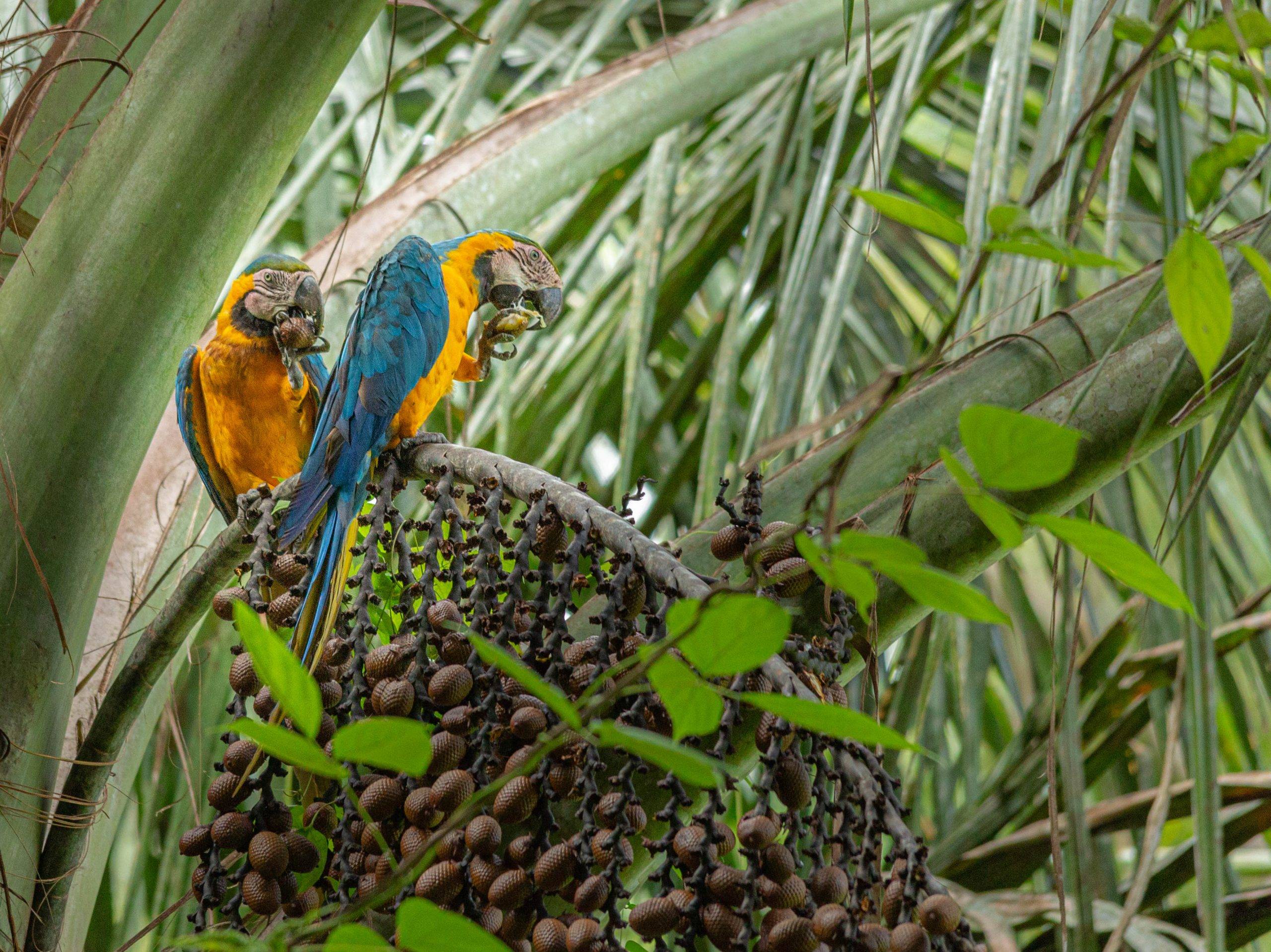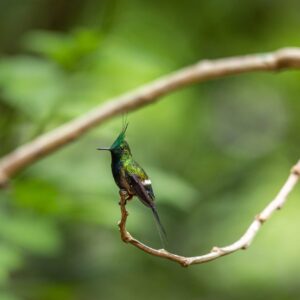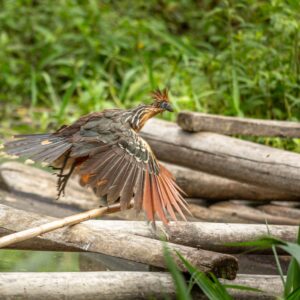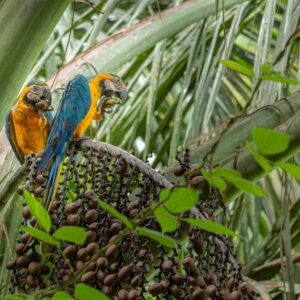
-
8 Day(s) 7 Night(s)
-
Max People : 26
-
Jan 1’ - Dec 31'
-
Min Age : 10+
Description
Birdwatching Manu National Park 8/7
The Birdwatching Manu National Park 8/7 Manu National Park has the highest biodiversity of any protected area in the world. Birdwatching Manu National Park 8/7 The unparalleled beauty of this trip is in the landscape and variety of habitats ranging from orchid-draped cloud forest where Spectacled Bears and Cock-of-the-Rocks still exist unbothered, to pristine Amazon rainforest with 13 primate species and oxbow lakes frequented by Giant Otters. A trip to Manu is a trip to one of the world´s great wilderness areas where wildlife is still plentiful and over 1000 species of birds have been recorded. Add to this a breathtaking visit to Machu Picchu and you have a trip of a lifetime Birdwatching Manu National Park 8/7.
Day 1: Cusco – Pilcopata Lodge or Bamboo Lodge
Departure from Cusco city very early in the morning in one of our trucks specially prepared for this road. We will pass through interesting Inter-Andean valleys and picturesque farmer communities. In the middle of the day we are going to visit the pre-Inca buried towers of Ninamarca, known as “chullpas”. After that we will arrive to Paucartambo city, which is a typical colonial town. It had a lot of importance and it still conserves it’s flavor. Birdwatching Manu National Park 8/7 Continuing our trip we drive up until the Abra of Accjanaco which is found at 3850 meters over the sea. From this point we start to go down passing through the cloud forest, which is an area rich in endemic species as the spectacular “Andean Bear” (Tremarctos Ornatus) and “The Cook of the Rock” (The Peruvian National Bird), “Orquis”, “Bromelias” and “Ferns” etc. Then in San Pedro we will visit a lek of “Cook of the Rocks”, in which these birds every morning and afternoon made during a very interesting dance called “Displays”. After that we continue our tour until reaching Pilcopata Lodge, where we will stop and spend our first night.
Day 2: Pilcopata Lodge – Blanquillo Ecolo
gical Reserve Lodge
Very early, at 06:30 a.m., we will leave in the direction of Port Atalaya; on the way we will make a few stops to visit the small, native communities of Patria and Pilcopata. These communities are known to be producers of many varieties of jungle fruits, even the famous Coca plant Birdwatching Manu National Park 8/7.
Later, we will continue our journey into the jungle by beginning the boating portion of the tour with a river excursion on the Madre de Dios, or “Mother of God” River, one of the tributaries of the mighty Amazon River.
During our day we will have the chance to witness many types of colorful birds such as parrots, Oropendolas, vultures and others species. Hopefully, we will also have the opportunity to see some jungle mammals such as monkeys or the famous capybaras (jungle rodents that are as much as 2.5 ft long). Towards the late afternoon, we will arrive to our next sleeping destination, Blanquillo Ecological reserve lodge, arriving approximately at 5:00 p.m.Birdwatching Manu National Park 8/7 Here, there will be showers and services available.
Day 3: Blanquillo Ecological Reserve Lodge – Macaw Clay Lick – Blanco Oxbow Lake
Very early in the morning before having our breakfast, using a totally camouflaged hidden place we will observe a Macaw Clay Lick. This is a clay wall on the riverside, where different species of Parrots and Macaws come down each morning to extract necessary minerals for their diet balance. Birdwatching Manu National Park 8/7 “The Parakeets”, “Amazon Parrot”, “The Blue headed Parrot” give an unforgettable pallet of colored wild life and as a perfectly finish to this picture the fabulous “Macaws” will arrive. Impressed by nature we return to our lodge. Digesting a good, strong lunch we continue the adventure with a walk for a few minutes to arrive to the Camungo Oxbow lake.Birdwatching Manu National Park 8/7 Before sailing on the lake, we will climb a metal tower (42 meters high) next to the lake from where we can get a beautiful view over the landscape. We will be enjoying this lake on a Catamaran all afternoon with the possibility of spotting “Giant Otters”. When it gets dark we are in the perfect position of spotting “Caimans” and with luck we will catch one of them. Still “shaking” after this exciting adventure we will go back to our Lodge to take a deserved rest after a delicious dinner.
Day 4: Blanquillo Ecological Reserve Lodge – Manu Biosphere Reserve
After having our breakfast we start the returning trip, but to do this we need to make a short stop in Boca Manu to get fuel for the boat. Then we will continue sailing up Manu River. With a brief stop at the park ranger station at Limonal to present our permits we travel for about five hours up the Manu. Birdwatching Manu National Park 8/7 Beaches, especially in the dry season, are loaded with nesting birds and feeding Herons, Egrets, Orinoco Geese, Terns and Skimmers to name a few. Some beaches will host sunning White and Black Caimans (South American relatives of the Alligators) and breeding Side-necked Turtles. Birdwatching Manu National Park 8/7 Hundreds of Sand-colored Nightjars roost during the day on logs and beaches and there is a chance of encountering a sunning Jaguar – the worlds third largest cat. In 1999 one in three of our trips saw Jaguar in Manu. We will see some species of primate on this river trip, possibly Red Howler Monkeys or the smaller Squirrel Monkeys. After having lunch by the river we arrive at our Safari Camp near the lake of Cocha Salvador. Birdwatching Manu National Park 8/7 We’ll have the afternoon to explore some of the trails through the pristine rainforest in the area. A visit to the lake of Cocha Otorongo is planned, where observation piers and a 20 meter observation tower in the rainforest canopy overlooking the lake are available for observing wildlife. We will also be on the lookout for a large family of Giant Otters that inhabit this lake. Before or after dinner an optional excursion into the forest at night is available with your guide in search of nocturnal creatures. Birdwatching Manu National Park 8/7 The lakes are full of eye-shine of the large Black Caiman and if we are lucky we may encounter an Olingo Kinkajou or even an Ocelot on the trails. Certainly the night-time noise of tree frogs and insects in the forest is an experience not to be forgotten. Night at Casa Matsiguenka Lodge.
Day 5: Manu Biosphere Reserve
After breakfast we’ll spend the morning at the lake of Cocha Salvador. Some of the time will be spent canoeing the lake on a floating platform observing oxbow lake animal life from the water. We may encounter an Agami Heron or a Sungrebe and Brown Cappuchin Monkeys are usually feeding on fruits nearby. Specially constructed piers that jut out into the lake enable us to look for a family of Giant Otters that live here. These, the worlds largest freshwater carnivores, remain common only in Manu, having been hunted to extinction throughout most of their former range. Each animal consumes between 4 and 5 kilos of fish daily and often they can be seen eating large fish on logs at the lakeside. The rest of the day will be spent walking the trails in the area in search of some of the 13 species of Monkey found in the forest here. Your guide will explain some of the basics of rainforest ecosystems and point out some of the medicinal plants of the area used by local, indigenous groups. We may cross paths with a group of Peccaries – a species of wild boar found here. A late afternoon swim in the river near the camp as the sun sets. Night at Casa Matsiguenka Lodge Birdwatching Manu National Park 8/7.
Day 6: Manu Biosphere Reserve – Hummingbird Lodge
Today we will walk from camp through the forest to a different oxbow lake, Cocha Otorongo – “Jaguar Lake”, to experience another setting and a chance to see further wildlife. We may encounter troops of monkeys especially the Common Woolly Monkey. We’ll pay special attention to the plant life and listen carefully for rustling vegetation and fruits falling to the rainforest floor indicating the presence of animals or large birds. After a leisurely lunch we take our canoes for a 4-hour trip down river until we reach Boca Manu for the night. Overnight at Hummingbird Lodge Birdwatching Manu National Park 8/7.
Day 7: Hummingbird Lodge – Bamboo Lodge
Today, after breakfast we will sail Alto Madre de Dios up river to the port of Atalaya, the place from where we started our trip by boat, after reach it we will drive to bamboo lodge where we are going to spend our last night in the jungle of Manu National Park.
Day 8: Bamboo Lodge – Cusco
GOOD BYE TO MANU!! On the day of our return, we will have an early morning departure from the bamboo Lodge in the direction of Paucartambo, which was the entrance point that led us into the jungle in the first place. At this time we will pass through the beautiful Sacred Valley on the way, arriving in Cusco around 7.00pm.
TRIPS CONSIDERATIONS
CLIMATE: Hot and humid in the lowlands to very cold at the Andes. This is a dry season tour, but there is the possibilty of a “Friaje”, a strong cold front moving up from the south that can bring periods of unusually cool weather and rain.
DIFFICULTY: Easy to Moderate. There are some long journeys and early starts, but the walking is usually fairly easy.
ACCOMMODATION: The jungle lodges are comfortable but simple; some do not have full-time electricity, but provide a generator for a few hours a day to charge batteries. Matsiguenka Camping Lodge in the Reserved Zone of Manu National Park has shared bathroom facilities and cold shower. Paradise Lodge and Manu Birding Lodge consists in double rooms with a private toilet and shower facilities. Hot and cold water is always available and all toilets facilities are flush.
Wildlife Photography: Opportunities are worthwhile.
What to Bring
We advise you to bring:
Besides from Binoculars and photo-equipment (the important Wildlife Enthusiast stuff) we advise:
Flashlight for night walk
Light day pack
A bottle or canteen to carry water on outings
Sunscreen and insect repellent
T-shirts and a long-sleeved shirt
Jeans or other cotton pants are comfortable, as well as quick-drying nylon ones.
Cotton socks
Light jacket, water resistant, or poncho
Hiking boots or sturdy shoes
Sandals for after hours
Hat that will not come off in windy boat rides and sunglasses
Plastic bags for camera, clothes, etc
Personal toiletries (shampoo, towel, etc)
NOTE: In rainy season we provide umbrella and rubber boots in many popular sizes for rainy days.
Manu Birding Lodge look forward to welcoming and guiding you soon!
Last minute bookings will be accepted but you must be aware that there is the possibility that we will not get space at the lodge or tour that you need.
PLEASE CONTACT US IF YOU HAVE ANY QUESTIONS OR CONCERNS.
PRICE: Birdwatching Manu National Park 8/7 : 2024 per person
1.- traveller $4350.00
2.- travellers $2750.00
4.- travellers $2200.00
6+ travellers $1900.00.
DISCOUNTS
18 to 25 years old: $30 USD Information required on student card: name of university, student name, photo of student, expiration date etc. A copy of the card is required at booking for government approval for discount.
Under 18 years old: $30 USD Please send us a copy of your passport at the time of booking.
Under 11 years old: $40 USD Please send us a copy of your passport at the time of booking.
Group of 5 or more: $30 USD – All you need is to book the trek together at the same time.
EXTRAS
Sleeping Bag –$20 USD per person per trek (It will be clean and warm)
Air Mattress –$20 USD per person per trek (Therm-a-rest mattresses)
Walking Poles -$20 USD per pair per trek (Professional poles that can be extended)
Personal tent- $35 USD – (Tent is for single trekkers only)
Vistadome Train Upgrade –$75 USD per person (Return Only)
Huayna Picchu Mountain –$75 USD per person (Please request when you book your Trek)
Machu Picchu Mountain – $75 USD per person (Please request when you book your Trek)
Single supplement-$35 USD per night (for solo travellers with single room)
**Huayna Picchu and Machu Picchu Mountain are optional treks within Machu Picchu Citadel which do not include a guide. The climb is usually done on your own after your tour of Machu Picchu Citadel. If you would like the extra hike to be guided, please request in advance. There is an extra cost for this extra guided tour.
ADDED VALUES FOR FREE
TRANSFER – from the Airport to Hotel (Cusco Only)
DUFFEL BAG AND LINER BAGS – included in the trekking price!
BOILED WATER is included along the Inca Trail
OXYGEN TANK will be available along the trek
EMERGENCY HORSE is included in the price which can be ridden if you get tired or sick
PLASTIC RAIN poncho made by Inca Land Adventures is included
Location
$1,900.00




Be the first to review “Birdwatching Manu National Park 8/7”